Sony HX95 vs Canon SX70
The Sony Cyber-shot DSC-HX95 and the Canon PowerShot SX70 HS are two digital cameras that were officially introduced, respectively, in August 2018 and September 2018. Both the HX95 and the SX70 are fixed lens compact cameras that are equipped with a 1/2.3-inch sensor. The Sony has a resolution of 18 megapixels, whereas the Canon provides 20.2 MP.
Below is an overview of the main specs of the two cameras as a starting point for the comparison.

Check HX95 offers at
ebay.com

Check SX70 price at
amazon.com
Going beyond this snapshot of core features and characteristics, what are the differences between the Sony Cyber-shot DSC-HX95 and the Canon PowerShot SX70 HS? Which one should you buy? Read on to find out how these two cameras compare with respect to their body size, their imaging sensors, their shooting features, their input-output connections, and their reception by expert reviewers.
Body comparison
The side-by-side display below illustrates the physical size and weight of the Sony HX95 and the Canon SX70. The two cameras are presented according to their relative size. Three consecutive views from the front, the top, and the rear side are shown. All width, height and depth measures are rounded to the nearest millimeter.
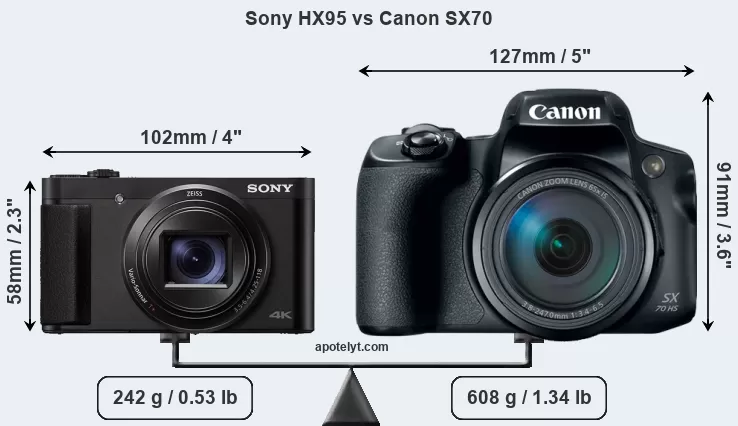
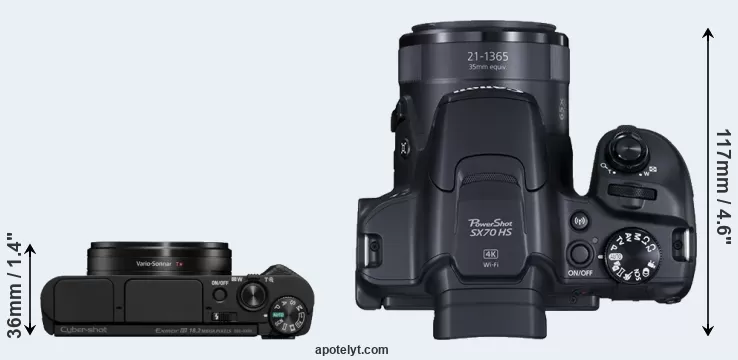
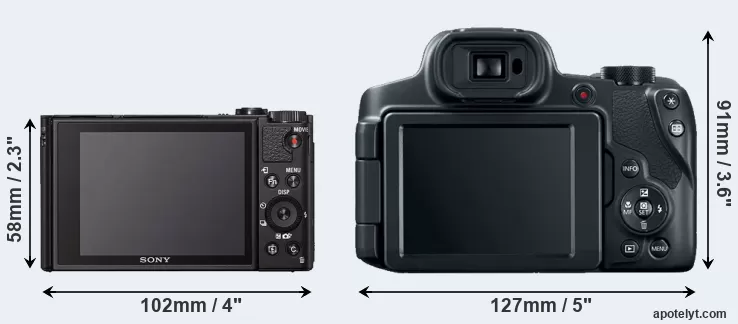
If the front view area (width x height) of the cameras is taken as an aggregate measure of their size, the Canon SX70 is considerably larger (95 percent) than the Sony HX95. Moreover, the SX70 is substantially heavier (151 percent) than the HX95. In this context, it is worth noting that neither the HX95 nor the SX70 are weather-sealed.
Concerning battery life, the HX95 gets 370 shots out of its Sony NP-BX1 battery, while the SX70 can take 325 images on a single charge of its Canon LP-E12 power pack. The power pack in the HX95 can be charged via the USB port, so that it is not always necessary to take the battery charger along when travelling.
The adjacent table lists the principal physical characteristics of the two cameras alongside a wider set of alternatives. If you want to switch the focus of the display and review another camera pair, you can move across to the CAM-parator tool and choose from the broad selection of possible camera comparisons there.

| Camera Model |
Camera Width |
Camera Height |
Camera Depth |
Camera Weight |
Battery Life |
Weather Sealing |
Camera Launch |
Launch Price (USD) |
Street Price |
||
|---|---|---|---|---|---|---|---|---|---|---|---|
| 1. | Sony HX95 | 102 mm | 58 mm | 36 mm | 242 g | 370 | n | Aug 2018 | 429 | ebay.com | |
| 2. | Canon SX70 | 127 mm | 91 mm | 117 mm | 608 g | 325 | n | Sep 2018 | 549 | amazon.com | |
| 3. | Canon G9 X Mark II | 98 mm | 58 mm | 31 mm | 206 g | 235 | n | Jan 2017 | 529 | ebay.com | |
| 4. | Canon SX60 | 128 mm | 93 mm | 114 mm | 650 g | 340 | n | Sep 2014 | 549 | ebay.com | |
| 5. | Canon SX730 | 110 mm | 64 mm | 40 mm | 300 g | 250 | n | Apr 2017 | 399 | ebay.com | |
| 6. | Canon SX740 | 110 mm | 64 mm | 40 mm | 299 g | 265 | n | Jul 2018 | 399 | amazon.com | |
| 7. | Nikon A1000 | 114 mm | 72 mm | 41 mm | 330 g | 250 | n | Jan 2019 | 429 | ebay.com | |
| 8. | Nikon W300 | 112 mm | 66 mm | 29 mm | 231 g | 280 | Y | May 2017 | 389 | ebay.com | |
| 9. | Panasonic ZS70 | 112 mm | 67 mm | 41 mm | 322 g | 380 | n | Apr 2017 | 449 | ebay.com | |
| 10. | Sony HX90V | 102 mm | 58 mm | 36 mm | 245 g | 360 | n | Apr 2015 | 429 | ebay.com | |
| 11. | Sony HX99 | 102 mm | 58 mm | 36 mm | 242 g | 370 | n | Aug 2018 | 449 | ebay.com | |
| 12. | Sony HX400V | 130 mm | 93 mm | 103 mm | 660 g | 300 | n | Feb 2014 | 499 | ebay.com | |
| 13. | Sony WX800 | 102 mm | 58 mm | 36 mm | 233 g | 370 | n | Oct 2018 | 399 | ebay.com | |
| Note: Measurements and pricing do not include easily detachable parts, such as add-on or interchangeable lenses or optional viewfinders. | |||||||||||
Any camera decision will naturally be influenced heavily by the price. The manufacturer’s suggested retail prices give an idea on the placement of the camera in the maker’s lineup and the broader market. The HX95 was launched at a somewhat lower price (by 22 percent) than the SX70, which makes it more attractive for photographers on a tight budget. Usually, retail prices stay at first close to the launch price, but after several months, discounts become available. Later in the product cycle and, in particular, when the replacement model is about to appear, further discounting and stock clearance sales often push the camera price considerably down.
Sensor comparison
The size of the imaging sensor is a crucial determinant of image quality. A large sensor will generally have larger individual pixels that offer better low-light sensitivity, provide wider dynamic range, and have richer color-depth than smaller pixels in a sensor of the same technological generation. Further, a large sensor camera will give the photographer additional creative options when using shallow depth-of-field to isolate a subject from its background. On the downside, larger sensors tend to be more expensive and lead to bigger and heavier cameras and lenses.
Both cameras under consideration feature a 1/2.3-inch sensor and have a format factor (sometimes also referred to as "crop factor") of 5.6. Within the spectrum of camera sensors, this places the review cameras among the smaller-sensor digicams that favor affordability and compact design. Both cameras feature a native aspect ratio (sensor width to sensor height) of 4:3.
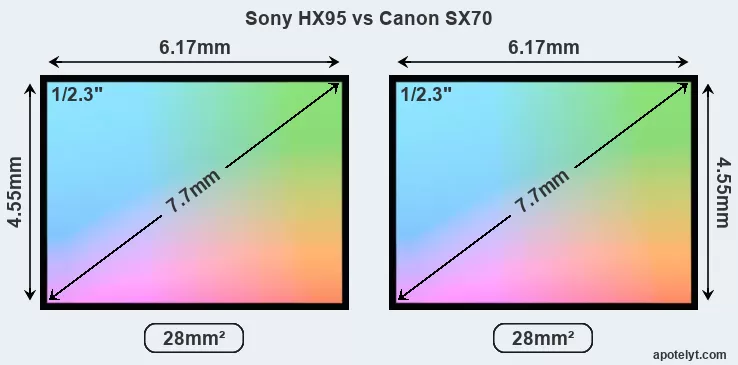
While the two cameras under review share the same sensor size, the SX70 offers a higher resolution of 20.2 megapixels, compared with 18 MP of the HX95. This megapixels advantage translates into a 6 percent gain in linear resolution. On the other hand, these sensor specs imply that the SX70 has a higher pixel density and a smaller size of the individual pixel (with a pixel pitch of 1.18μm versus 1.25μm for the HX95). It is noteworthy in this context that the two cameras were released in close succession, so that their sensors are from the same technological generation. Coming back to sensor resolution, it should be mentioned that neither of the two cameras has an anti-alias filter installed, so they are able to capture all the detail the sensor resolves.
The resolution advantage of the Canon SX70 implies greater flexibility for cropping images or the possibility to print larger pictures. The maximum print size of the SX70 for good quality output (200 dots per inch) amounts to 25.9 x 19.4 inches or 65.8 x 49.4 cm, for very good quality (250 dpi) 20.7 x 15.6 inches or 52.7 x 39.5 cm, and for excellent quality (300 dpi) 17.3 x 13 inches or 43.9 x 32.9 cm. The corresponding values for the Sony HX95 are 24.5 x 18.4 inches or 62.2 x 46.6 cm for good quality, 19.6 x 14.7 inches or 49.7 x 37.3 cm for very good quality, and 16.3 x 12.2 inches or 41.5 x 31.1 cm for excellent quality prints.
The Sony Cyber-shot DSC-HX95 has a native sensitivity range from ISO 80 to ISO 3200, which can be extended to ISO 80-6400. The corresponding ISO settings for the Canon PowerShot SX70 HS are ISO 100 to ISO 3200 (no boost).
In terms of underlying technology, the HX95 is build around a CMOS sensor, while the SX70 uses a BSI-CMOS imager. Both cameras use a Bayer filter for capturing RGB colors on a square grid of photosensors. This arrangement is found in most digital cameras.
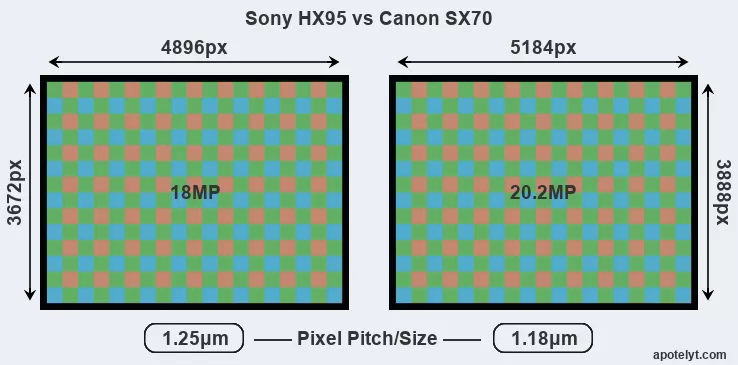
Consistent information on actual sensor performance is available from DXO Mark for many cameras. This service is based on lab testing and assigns an overall score to each camera sensor, as well as ratings for dynamic range ("DXO Landscape"), color depth ("DXO Portrait"), and low-light sensitivity ("DXO Sports"). The following table provides an overview of the physical sensor characteristics, as well as the sensor quality measurements for a selection of comparators.

| Camera Model |
Sensor Class |
Resolution (MP) |
Horiz. Pixels |
Vert. Pixels |
Video Format |
DXO Portrait |
DXO Landscape |
DXO Sports |
DXO Overall |
||
|---|---|---|---|---|---|---|---|---|---|---|---|
| 1. | Sony HX95 | 1/2.3 | 18.0 | 4896 | 3672 | 4K/30p | 20.6 | 12.1 | 1057 | 51 | |
| 2. | Canon SX70 | 1/2.3 | 20.2 | 5184 | 3888 | 4K/30p | 20.6 | 12.1 | 1063 | 51 | |
| 3. | Canon G9 X Mark II | 1-inch | 20.0 | 5472 | 3648 | 1080/60p | 21.9 | 12.5 | 522 | 65 | |
| 4. | Canon SX60 | 1/2.3 | 14.2 | 4608 | 3072 | 1080/60p | 19.2 | 10.8 | 127 | 39 | |
| 5. | Canon SX730 | 1/2.3 | 20.2 | 5184 | 3888 | 1080/60p | 20.5 | 11.9 | 924 | 50 | |
| 6. | Canon SX740 | 1/2.3 | 20.2 | 5184 | 3888 | 4K/30p | 20.6 | 12.1 | 1050 | 51 | |
| 7. | Nikon A1000 | 1/2.3 | 15.9 | 4608 | 3456 | 4K/30p | 20.7 | 12.2 | 1095 | 52 | |
| 8. | Nikon W300 | 1/2.3 | 15.9 | 4608 | 3456 | 4K/30p | 20.5 | 12.0 | 938 | 50 | |
| 9. | Panasonic ZS70 | 1/2.3 | 20.2 | 5184 | 3888 | 4K/30p | 19.1 | 10.6 | 106 | 36 | |
| 10. | Sony HX90V | 1/2.3 | 18.0 | 4896 | 3672 | 1080/60p | 20.2 | 11.6 | 738 | 47 | |
| 11. | Sony HX99 | 1/2.3 | 18.0 | 4896 | 3672 | 4K/30p | 20.6 | 12.1 | 1058 | 51 | |
| 12. | Sony HX400V | 1/2.3 | 20.2 | 5184 | 3888 | 1080/60p | 20.1 | 11.4 | 629 | 45 | |
| 13. | Sony WX800 | 1/2.3 | 18.0 | 4896 | 3672 | 4K/30p | 20.6 | 12.2 | 1070 | 51 | |
| Note: DXO values in italics represent estimates based on sensor size and age. | |||||||||||
Many modern cameras are not only capable of taking still images, but also of capturing video footage. Both cameras under consideration are equipped with sensors that have a sufficiently high read-out speed for moving images, and both provide the same movie specifications (4K/30p).
Feature comparison
Apart from body and sensor, cameras can and do differ across a range of features. The two cameras under review are similar with respect to both having an electronic viewfinder. However, the one in the SX70 offers a substantially higher resolution than the one in the HX95 (2360k vs 638k dots). The table below summarizes some of the other core capabilities of the Sony HX95 and Canon SX70 in connection with corresponding information for a sample of similar cameras.

| Camera Model |
Viewfinder (Type or 000 dots) |
Control Panel (yes/no) |
LCD Specifications (inch/000 dots) |
LCD Attach- ment |
Touch Screen (yes/no) |
Max Shutter Speed * |
Max Shutter Flaps * |
Built-in Flash (yes/no) |
Built-in Image Stab |
||
|---|---|---|---|---|---|---|---|---|---|---|---|
| 1. | Sony HX95 | 638 | n | 3.0 / 922 | tilting | n | 1/2000s | 10.0/s | Y | Y | |
| 2. | Canon SX70 | 2360 | n | 3.0 / 922 | swivel | n | 1/2000s | 10.0/s | Y | Y | |
| 3. | Canon G9 X Mark II | none | n | 3.0 / 1040 | fixed | Y | 1/2000s | 8.2/s | Y | Y | |
| 4. | Canon SX60 | 922 | n | 3.0 / 922 | swivel | n | 1/2000s | 6.4/s | Y | Y | |
| 5. | Canon SX730 | none | n | 3.0 / 922 | tilting | n | 1/3200s | 5.9/s | Y | Y | |
| 6. | Canon SX740 | none | n | 3.0 / 922 | tilting | n | 1/3200s | 10.0/s | Y | Y | |
| 7. | Nikon A1000 | 1166 | n | 3.0 / 1036 | tilting | Y | 1/4000s | 7.0/s | Y | Y | |
| 8. | Nikon W300 | none | n | 3.0 / 921 | fixed | n | 1/4000s | 7.0/s | Y | Y | |
| 9. | Panasonic ZS70 | 1166 | n | 3.0 / 1040 | tilting | Y | 1/2000s | 10.0/s | Y | Y | |
| 10. | Sony HX90V | 638 | n | 3.0 / 921 | tilting | n | 1/2000s | 10.0/s | Y | Y | |
| 11. | Sony HX99 | 638 | n | 3.0 / 922 | tilting | Y | 1/2000s | 10.0/s | Y | Y | |
| 12. | Sony HX400V | 210 | n | 3.0 / 921 | tilting | n | 1/4000s | 10.0/s | Y | Y | |
| 13. | Sony WX800 | none | n | 3.0 / 922 | tilting | Y | 1/2000s | 10.0/s | Y | Y | |
| Note: *) Information refers to the mechanical shutter, unless the camera only has an electronic one. | |||||||||||
Both the HX95 and the SX70 have zoom lenses built in. The HX95 has a 24-720mm f/3.5-6.4 optic and the SX70 offers a 21-1365mm f/3.4-6.5 (focal lengths in full frame equivalent terms). Hence, the Canon provides a wider angle of view at the short end, as well as more tele-photo reach at the long end than the Sony. The SX70 offers the faster maximum aperture.
The HX95 writes its imaging data to SDXC or Memory Stick PRO Duo cards, while the SX70 uses SDXC cards. The SX70 supports UHS-I cards (Ultra High Speed data transfer of up to 104 MB/s), while the HX95 cannot take advantage of Ultra High Speed SD cards.
Connectivity comparison
For some imaging applications, the extent to which a camera can communicate with its environment can be an important aspect in the camera decision process. The table below provides an overview of the connectivity of the Sony Cyber-shot DSC-HX95 and Canon PowerShot SX70 HS and, in particular, the interfaces the cameras (and selected comparators) provide for accessory control and data transfer.

| Camera Model |
Hotshoe Port |
Internal Mic / Speaker |
Microphone Port |
Headphone Port |
HDMI Port |
USB Port |
WiFi Support |
NFC Support |
Bluetooth Support |
||
|---|---|---|---|---|---|---|---|---|---|---|---|
| 1. | Sony HX95 | - | stereo / mono | - | - | micro | 2.0 | Y | Y | Y | |
| 2. | Canon SX70 | - | stereo / mono | Y | - | micro | 2.0 | Y | - | Y | |
| 3. | Canon G9 X Mark II | - | stereo / mono | - | - | micro | 2.0 | Y | Y | Y | |
| 4. | Canon SX60 | Y | stereo / mono | Y | - | mini | 2.0 | Y | Y | - | |
| 5. | Canon SX730 | - | stereo / mono | - | - | micro | 2.0 | Y | Y | Y | |
| 6. | Canon SX740 | - | stereo / mono | - | - | micro | 2.0 | Y | - | Y | |
| 7. | Nikon A1000 | - | stereo / mono | - | - | micro | 2.0 | Y | - | Y | |
| 8. | Nikon W300 | - | stereo / mono | - | - | micro | 2.0 | Y | - | Y | |
| 9. | Panasonic ZS70 | - | stereo / mono | - | - | micro | 2.0 | Y | - | - | |
| 10. | Sony HX90V | - | stereo / mono | - | - | micro | 2.0 | Y | Y | - | |
| 11. | Sony HX99 | - | stereo / mono | - | - | micro | 2.0 | Y | Y | Y | |
| 12. | Sony HX400V | Y | stereo / mono | - | - | micro | 2.0 | Y | Y | - | |
| 13. | Sony WX800 | - | stereo / mono | - | - | micro | 2.0 | Y | Y | - |
It is notable that the SX70 has a microphone port, which can help to improve the quality of audio recordings by attaching an external microphone. The HX95 does not feature such a mic input.
The SX70 is a recent model that features in the current product line-up of Canon. In contrast, the HX95 has been discontinued (but can be found pre-owned on ebay). There has not been a direct replacement model for the HX95 from Sony. Further information on the features and operation of the HX95 and SX70 can be found, respectively, in the Sony HX95 Manual (free pdf) or the online Canon SX70 Manual.
Review summary
So what conclusions can be drawn? Is the Sony HX95 better than the Canon SX70 or vice versa? Below is a summary of the relative strengths of each of the two contestants.

Reasons to prefer the Sony Cyber-shot DSC-HX95:
- More compact: Is smaller (102x58mm vs 127x91mm) and thus needs less room in the bag.
- Less heavy: Is lighter (by 366g or 60 percent) and hence easier to carry around.
- Longer lasting: Can take more shots (370 versus 325) on a single battery charge.
- Easier travel charging: Can be conveniently charged via its USB port.
- Easier device pairing: Supports NFC for fast wireless image transfer over short distances.
- More affordable: Was introduced into a lower priced segment (22 percent cheaper at launch).

Advantages of the Canon PowerShot SX70 HS:
- More detail: Has more megapixels (20.2 vs 18MP), which boosts linear resolution by 6%.
- Better sound: Can connect to an external microphone for higher quality sound recording.
- More detailed viewfinder: Has higher resolution electronic viewfinder (2360k vs 638k dots).
- More flexible LCD: Has a swivel screen for odd-angle shots in portrait or landscape orientation.
- Better light gathering: Has a lens with a wider maximum aperture (f/3.4 vs f/3.5).
- Wider view: Has a wider-angle lens that facilitates landscape or interior shots.
- More tele-reach: Has a longer tele-lens for perspective compression and subject magnification.
- Faster buffer clearing: Has an SD card interface that supports the UHS-I standard.
If the count of individual advantages (bullet points above) is taken as a guide, the SX70 emerges as the winner of the match-up (8 : 6 points). However, the relative importance of the various individual camera aspects will vary according to personal preferences and needs, so that you might like to apply corresponding weights to the particular features before making a decision on a new camera. A professional sports photographer will view the differences between cameras in a way that diverges from the perspective of a street photog, and a person interested in family portraits has distinct needs from a landscape shooter. Hence, the decision which camera is best and worth buying is often a very personal one.
How about other alternatives? Do the specifications of the Sony HX95 and the Canon SX70 place the cameras among the top in their class? Find out in the latest Best Superzoom Camera listing whether the two cameras rank among the cream of the crop.
In any case, while the comparison of technical specifications can provide a useful overview of the capabilities of different cameras, it says little about, for example, the shooting experience and imaging performance of the HX95 and the SX70 in practical situations. User reviews that are available, for instance, at amazon can sometimes shed light on these issues, but such feedback is all too often partial, inconsistent, and inaccurate.
Expert reviews
This is why expert reviews are important. The adjacent summary-table relays the overall verdicts of several of the most popular camera review sites (amateurphotographer [AP], cameralabs [CL], digitalcameraworld [DCW], dpreview [DPR], ephotozine [EPZ], photographyblog [PB]). As can be seen, the professional reviewers agree in many cases on the quality of different cameras, but sometimes their assessments diverge, reinforcing the earlier point that a camera decision is often a very personal choice.

| Camera Model |
AP score |
CL score |
DCW score |
DPR score |
EPZ score |
PB score |
Camera Launch |
Launch Price (USD) |
Street Price |
||
|---|---|---|---|---|---|---|---|---|---|---|---|
| 1. | Sony HX95 | .. | .. | .. | .. | .. | .. | Aug 2018 | 429 | ebay.com | |
| 2. | Canon SX70 | .. | + + | 3.5/5 | .. | 3.5/5 | 3.5/5 | Sep 2018 | 549 | amazon.com | |
| 3. | Canon G9 X Mark II | 4/5 | .. | 4/5 | 75/100 | 4.5/5 | 4.5/5 | Jan 2017 | 529 | ebay.com | |
| 4. | Canon SX60 | 3/5 | + + | .. | 75/100 | 4/5 | 4.5/5 | Sep 2014 | 549 | ebay.com | |
| 5. | Canon SX730 | .. | + | .. | .. | 4/5 | 4/5 | Apr 2017 | 399 | ebay.com | |
| 6. | Canon SX740 | .. | + | 3.5/5 | .. | 4/5 | 4/5 | Jul 2018 | 399 | amazon.com | |
| 7. | Nikon A1000 | .. | + + | 3.5/5 | .. | 3.5/5 | 3/5 | Jan 2019 | 429 | ebay.com | |
| 8. | Nikon W300 | .. | + | .. | .. | 4/5 | 4/5 | May 2017 | 389 | ebay.com | |
| 9. | Panasonic ZS70 | .. | + + | .. | .. | 4/5 | 4/5 | Apr 2017 | 449 | ebay.com | |
| 10. | Sony HX90V | 4/5 | + + | .. | .. | 4/5 | 4.5/5 | Apr 2015 | 429 | ebay.com | |
| 11. | Sony HX99 | .. | .. | .. | .. | 4/5 | 4.5/5 | Aug 2018 | 449 | ebay.com | |
| 12. | Sony HX400V | 4/5 | + + | .. | .. | 4/5 | 4/5 | Feb 2014 | 499 | ebay.com | |
| 13. | Sony WX800 | .. | .. | .. | .. | .. | .. | Oct 2018 | 399 | ebay.com | |
| Note: (+ +) highly recommended; (+) recommended; (o) reviewed; (..) not available. | |||||||||||
The review scores listed above should be treated with care, though. The assessments were made in relation to similar cameras of the same technological generation. Thus, a score needs to be put into the context of the launch date and the launch price of the camera, and rating-comparisons among cameras that span long time periods or concern very differently equipped models make little sense. It should also be noted that some of the review sites have over time altered the way they render their verdicts.

Check HX95 offers at
ebay.com

Check SX70 price at
amazon.com
Other camera comparisons
Did this review help to inform your camera decision process? If you would like to see a different side-by-side camera review, just make a corresponding selection in the search boxes below. Alternatively, you can follow any of the listed hyperlinks for comparisons that others found interesting.
- Canon 1D Mark II N vs Sony HX95
- Canon 2000D vs Sony HX95
- Canon M5 vs Sony HX95
- Canon M50 vs Sony HX95
- Canon S120 vs Canon SX70
- Canon SX70 vs Fujifilm X-T5
- Canon SX70 vs Olympus E-5
- Canon SX70 vs Pentax K-70
- Canon SX70 vs Samsung NX1
- Canon SX70 vs Sony ZV-1F
- Fujifilm X-Pro3 vs Sony HX95
- Panasonic FZ100 vs Sony HX95
Specifications: Sony HX95 vs Canon SX70
Below is a side-by-side comparison of the specs of the two cameras to facilitate a quick review of their differences and common features.
| Camera Model | Sony HX95 | Canon SX70 |
|---|---|---|
| Camera Type | Fixed lens compact camera | Fixed lens compact camera |
| Camera Lens | 24-720mm f/3.5-6.4 | 21-1365mm f/3.4-6.5 |
| Launch Date | August 2018 | September 2018 |
| Launch Price | USD 429 | USD 549 |
| Sensor Specs | Sony HX95 | Canon SX70 |
| Sensor Technology | CMOS | BSI-CMOS |
| Sensor Format | 1/2.3" Sensor | 1/2.3" Sensor |
| Sensor Size | 6.17 x 4.55 mm | 6.17 x 4.55 mm |
| Sensor Area | 28.0735 mm2 | 28.0735 mm2 |
| Sensor Diagonal | 7.7 mm | 7.7 mm |
| Crop Factor | 5.6x | 5.6x |
| Sensor Resolution | 18 Megapixels | 20.2 Megapixels |
| Image Resolution | 4896 x 3672 pixels | 5184 x 3888 pixels |
| Pixel Pitch | 1.25 μm | 1.18 μm |
| Pixel Density | 64.04 MP/cm2 | 71.80 MP/cm2 |
| Moiré control | no AA filter | no AA filter |
| Movie Capability | 4K/30p Video | 4K/30p Video |
| ISO Setting | 80 - 3,200 ISO | 100 - 3,200 ISO |
| ISO Boost | 80 - 6,400 ISO | no Enhancement |
| Image Processor | BIONZ X | DIGIC 8 |
| Screen Specs | Sony HX95 | Canon SX70 |
| Viewfinder Type | Electronic viewfinder | Electronic viewfinder |
| Viewfinder Field of View | 100% | 100% |
| Viewfinder Resolution | 638k dots | 2360k dots |
| LCD Framing | Live View | Live View |
| Rear LCD Size | 3.0inch | 3.0inch |
| LCD Resolution | 922k dots | 922k dots |
| LCD Attachment | Tilting screen | Swivel screen |
| Shooting Specs | Sony HX95 | Canon SX70 |
| Focus System | Contrast-detect AF | Contrast-detect AF |
| Manual Focusing Aid | no Peaking Feature | Focus Peaking |
| Max Shutter Speed (mechanical) | 1/2000s | 1/2000s |
| Continuous Shooting | 10 shutter flaps/s | 10 shutter flaps/s |
| Fill Flash | Built-in Flash | Built-in Flash |
| Storage Medium | MS or SDXC cards | SDXC cards |
| Single or Dual Card Slots | Single card slot | Single card slot |
| UHS card support | no | UHS-I |
| Connectivity Specs | Sony HX95 | Canon SX70 |
| External Flash | no Hotshoe | no Hotshoe |
| USB Connector | USB 2.0 | USB 2.0 |
| HDMI Port | micro HDMI | micro HDMI |
| Microphone Port | no MIC socket | External MIC port |
| Wifi Support | Wifi built-in | Wifi built-in |
| Near-Field Communication | NFC built-in | no NFC |
| Bluetooth Support | Bluetooth built-in | Bluetooth built-in |
| Body Specs | Sony HX95 | Canon SX70 |
| Battery Type | Sony NP-BX1 | Canon LP-E12 |
| Battery Life (CIPA) | 370 shots per charge | 325 shots per charge |
| In-Camera Charging | USB charging | no USB charging |
| Body Dimensions |
102 x 58 x 36 mm (4.0 x 2.3 x 1.4 in) |
127 x 91 x 117 mm (5.0 x 3.6 x 4.6 in) |
| Camera Weight | 242 g (8.5 oz) | 608 g (21.4 oz) |

Check HX95 offers at
ebay.com

Check SX70 price at
amazon.com
Did you notice an error on this page? If so, please get in touch, so that we can correct the information.

